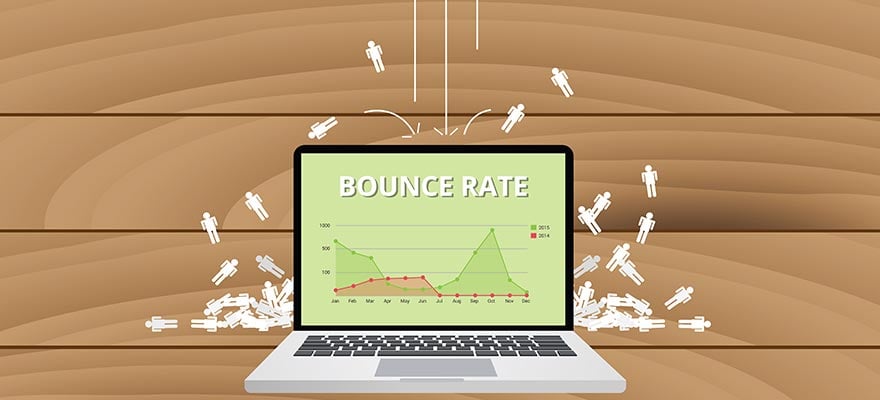How do I reduce the bounce rate on my website?
Worried about how high your bounce rate is? Read this speedy guide to get some useful tips on bringing it down across your whole website.

A key engagement metric that if you're not worrying about then you should be! In all seriousness it's a pretty good indicator of how effective your content is at delighting your visitors, or otherwise.
We get lots of questions from clients about bounce rates on their sites, so here's a (hopefully) quick guide to everything you need to know about bounce!
What is a bounce rate?
Ok so a Google Analytics classes a user 'bouncing' if they visited the page and didn't take any further action. They didn't click on any of the links or interact with the page in any way.
Notice how we got you to click to load the rest of the post? That's a common technique in blogs nowadays to get that interaction logged and get the bounce rate down. We'll discuss more techniques later.
What's a good/bad bounce rate?
A tricky one to start with. Low is good, high is bad. How's that? Just kidding...
Google about for figures on what the average bounce rate is for a B2B website, and you'll get wild estimations of 25%-60%. Frankly you can expect that site wide on any site. I've seen home pages with 20% bounce rates and their most popular blogs with 80% bounce rates.
To give an example, research by Brafton found the average bounce rate for B2B sites is 61.03%, compared to 54.25% for B2C sites. Interestingly out of the websites observed, the financial services industry led the way with the lowest bounce rate of 53%, whereas management consulting lagged behind at 67.5%
Essentially all optimisation of a web page should be geared to decreasing the bounce rate of the page, so bear that in mind when you go into edit a page.
What's the source of your traffic?
If you've got some problem pages that are just not working for visitors, look at where the traffic for those pages is coming from.
If it's from paid advertising then I suggest very strongly you set to work rectifying the situation. Google will lower your quality score if it sends users to your page from an advert and they disconnect immediately. It'll force the cost of your adverts up and give you less prominent placement in favour of advert to landing page combinations that do work.
That disconnect can be repeated in normal organic SERPs. Titles and meta descriptions that are created at the start of a pages life that aren't updated as the page content is added to will frustrate and confuse a user into clicking away. If you don't want to alter the title and meta of the page but the content that they specifically relate to are now pushed further down the page in favour of other items, try including an anchor menu on your page to helpfully and easily direct people down to what they're looking for.
What's the purpose of the page?
If you asked me which page on a website is most likely to have the highest bounce rate, I would always say the contact page. That's not necessarily a bad thing.
If all you've got on your contact page is form then that could be a bad thing as it implies they're not filling in the form to contact you. More than likely in a B2B environment, the visitor is looking for your postal address and/or telephone number, so they might just be jotting those down.
If the intent of the page isn't to furnish people with details for offline activities, then a high bounce is a warning sign that the content isn't right.
Bounce rates are a quantitive value, giving you an overall picture of how the page is engaged with. Heatmaps can do something similar, but obviously they can give you a better view of what those who do interact with the page are doing.
Check the scroll on the heatmap, it's easy suggest that people are aware they should scroll to find more content on the site but it's best to check that the layout isn't making them think what appears on screen above the fold is all there is. If you find people aren't scrolling then it might be a good idea to introduce an anchor menu or at least an icon to suggest they scroll down the page for more.
If you look on the heatmap and find that people are clicking on an item further down regularly, consider promoting that item to further up the page above the fold. If you have a platform like HubSpot, it's easy to A/B test messages on calls to action to see which resonate best with your audience.
Different personas need different 'sells' when it comes to website. What can seem like positive offering might be a negative to some if worded incorrectly. Keep it flexible and measurable to get better results through monitoring.
Many heatmap tools will give you the option to record your visitors interacting with your pages. This is a much more finite qualitative review of your content but still very important for making changes to your page based on data rather than best guesses.
Tools, tricks, tips and Twitter
The HubSpot COS platform offers the flexibility of including custom modules on pages, which in the past has afforded us the opportunity to not only create useful tools for visitors to engage with, it's also opened the door to connect via the HubSpot API form submission system, to easily collect data in exchange for free assets and downloads etc
This isn't limited to HubSpot of course, you could achieve, with the right development team, something similar with something like WordPress. The key really is are your producing something that will actually engage and help your visitor?
Content and inbound marketing are concepts that have been around for a while now, so there's a flood of content out there for users to wade through and digest as it is. It's pointless to add more to the pile unless it stands out.
Video is very popular now, but again it's a trend that a lot of people have jumped on so the web is probably going to be awash with it whatever the subject you're targeting is.
Giving people something to do is great. Obviously we mentioned the trigger at the top of this blog, but that can be a quick survey so you're capturing data about your users as a gate to your content. Sites like PlayBuzz offer really straightforward easy to embed content like quizzes to add to your site, which will give them extra share-ability points.
And promotion of content, not just on Twitter, all forms of social media, and specifically go for areas of those social media sites where your content is most likely to resonate. If you can drive interested parties to your website pages and give them a good experience, that will be reflected in the popularity of the page, in the bounce rate, and ultimately, your position in the search results.
All this can feel like a lot of plates to spin. So if you're looking for a helping hand, don't hesitate to get in touch for a no obligation consultation. We'll provide some free, actionable tips on how to improve your website's performance, what key metrics to look out for and how you stack up against your competitors. Simply book a call with one of our consultants today.
 Paul Marshall
Paul Marshall